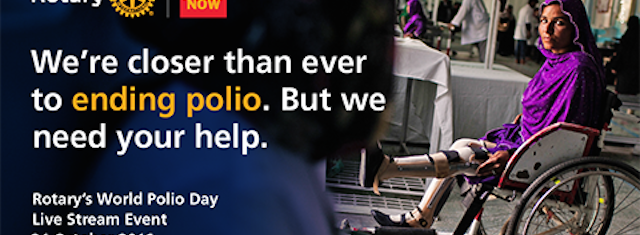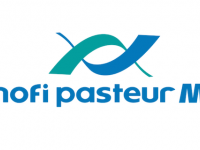Health
The eradication of Poliomyelitis is in sight by SANOFI PASTEUR
Expected to save 50$Bn within 20 years

World Polio Day (Source: endpolio.org)
USPA NEWS -
Sanofi Pasteur and Rotary International marked World Polio Day today by bringing together international experts for an update on the major progress made in the program that should soon lead to the disease eradication. Through the Global Polio Eradication Initiative (GPEI), the disease has been 99% .
Sanofi Pasteur and Rotary International marked World Polio Day today by bringing together international experts for an update on the major progress made in the program that should soon lead to the disease eradication. Through the Global Polio Eradication Initiative (GPEI), the world´s largest public-private public health partnership, the disease has been 99% eliminated. All participants are mobilizing during the last leg of the race to make polio the second human disease eradicated after smallpox. Alongside other major partners, Sanofi Pasteur and Rotary International recognize the decisive role of vaccinators on the ground, and they invite two "polio heroes" from Pakistan to share their daily commitment, despite cultural and geopolitical barriers, often risking their lives in this country where vaccination teams are sometimes targeted.
THE LAST BATTLE AGAINST POLIO-----------------------------------------------------------------------------------------------------
An infectious disease caused by a virus that invades the nervous system, polio can cause irreversible paralysis within hours. Polio can strike at any age, but children under five are most at risk. Today, polio caused by wild polioviruses survives only in parts of the last three countries considered endemic by the World Health Organization (WHO): Afghanistan, Nigeria and Pakistan. Vaccinating all children, and effectively reaching children in those areas at risk, will ensure future generations of a world free of polio.
ESTIMATES SUGGEST MORE THAN 350 000 PEOPLE WERE PARALYSED BY POLIO-------------------------------------Estimates suggest more than 350,000 people were paralyzed by polio worldwide in 1988; in more than 120 endemic countries. [1] Since the beginning of 2016, 27 cases were reported in only three countries - Afghanistan, Nigeria and Pakistan[2] - in which circulation of wild poliovirus has never stopped. Four new cases of polio were reported in Nigeria this summer in difficult-to-access areas near Lake Chad, the first polio cases reported on the African continent since the summer of 2014. The government of Nigeria has allocated significant resources to the affected area and launched a large-scale vaccination campaign with the support of global public health organizations. Countries around the Lake Chad basin have declared the outbreak a regional public health emergency. Polio has been eliminated in Europe since 2010. In France, which has good vaccination coverage, the last case of indigenous polio was in 1989 and the last imported case in 1995. [3]
Michel Zaffran, Director for polio eradication at the World Health Organization declared: "There is no doubt that right now we have the best conditions in history to finish this fight. But at the same time, key challenges must be overcome. All children in the remaining infected areas must be reached and fully immunized and the international community must follow the strong example set by Rotary to rapidly mobilize all needed financial resources to complete the job.“ Zaffran highlighted that while success in the near-term is entirely possible, failure could lead to a global resurgence of the disease.
According to Dr. Kimberly Thompson, Professor of Preventive Medicine at the University of Central Florida in the United States and President of Kid Risk, Inc. who has studied the economics of polio eradication: "We estimated that the world should expect 40 to 50 billion US dollars in net savings from investments in the Global Polio Eradication Initiative."
THE LARGEST PUBLIC HEALTH PROGRAM IN HISTORY-------------------------------------------------------------------------
National governments, WHO, Rotary International, the US Centers for Disease Control and Prevention (CDC) and UNICEF have been historical partners of this initiative for nearly 30 years. "Rotary members worldwide have managed to create community centers and draw the attention of politicians," notes Christian Michaud, coordinator of "Polio Plus" France and Maghreb for Rotary. He added: "To achieve this historic goal, it is necessary that all of the participants involved continue their efforts. At a time when the danger seems far away and is no longer at the heart of the political agenda, it is now that we must convince governments and health authorities of the different countries not to relax their attention and to be involved in the final stages of polio eradication." The main supplier of both vaccines, oral polio vaccine (OPV) and the injectable inactivated polio vaccine (IPV), Sanofi Pasteur has been a partner of the Global Polio Eradication Initiative since its launch. The company provided more than six billion doses of OPV and large quantities of IPV vaccine or vaccines containing IPV from its production centers in Marcy l'Etoile near Lyon and Val de Reuil, Normandy. "In the space of half a century, science has allowed us to understand this disease and to find the only way to combat it: vaccination. Our biotechnological expertise allowed us to advance to an industrial scale so that, today, every child, born anywhere in the world, has access to polio vaccines," said David Loew, Executive Vice President, Sanofi Pasteur.
TRIBUTE TO THE "POLIO HEROES"------------------------------------------------------------------------------------------------------
The contributions of major international entities would be in vain without the 20 million volunteers worldwide who collectively have immunized more than three billion children. Vaccinators in Pakistan, Azra and Latif recounted their daily actions. "I want the children of my country to be healthy and protected from polio,“ said Latif. “I have participated in this fight from the beginning and I want to continue to the end, to see a polio-free Pakistan."---------------------------------------------
Azra is a female "health worker" in South Punjab who has provided polio vaccinations for 20 years. Despite difficulties, Azra says that nothing can alter her passion for her work at the forefront of the fight against polio. ------------------------------ABOUT SANOFI
Sanofi, a global healthcare leader, discovers, develops and distributes therapeutic solutions focused on patients' needs. Sanofi is organized into five global business units: Diabetes and Cardiovascular, General Medicines and Emerging Markets, Sanofi Genzyme, Sanofi Pasteur and Merial. Sanofi is listed in Paris (EURONEXT: SAN) and in New York (NYSE: SNY).
Sanofi Pasteur, the vaccines division of Sanofi, provides more than 1 billion doses of vaccine each year, making it possible to immunize more than 500 million people across the globe. A world leader in the vaccine industry, Sanofi Pasteur produces a portfolio of high quality vaccines that matches its areas of expertise and meets public-health demand. The company's heritage, to create vaccines that protect life, dates back more than a century. Sanofi Pasteur is the largest company entirely dedicated to vaccines. Every day, the company invests more than EUR 1 million in research and development. Source Sanofi
[1] WHO. Poliomyelitis. Fact sheet N°114 ““ updated September 2016. Available at: http://www.who.int/mediacentre/factsheets/fs114/fr/
[2] Global Polio Eradication Initiative Data and Monitoring. Polio this week. Available at: http://www.polioeradication.org/Dataandmonitoring/Poliothisweek.aspx
[3] http://www.polio-france.org/poliomyelite/un-peu-dhistoire/
Liability for this article lies with the author, who also holds the copyright. Editorial content from USPA may be quoted on other websites as long as the quote comprises no more than 5% of the entire text, is marked as such and the source is named (via hyperlink).








